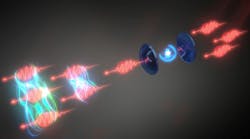In a milestone for quantum photonics, a group of researchers from the University of Sydney (Australia), University of Basel (Switzerland), and Ruhr University Bochum (Germany) just cracked open the door to manipulating quantum light.
They did this by measuring the direct time delay between one photon and a pair of bound photons scattering off a single quantum dot (see video).
Sahand Mahmoodian, a theoretical physicist at the University of Sydney, has been inspired by nonlinear optics at the quantum level for a while now. After doing some calculations (in earlier work), he showed that if atoms are ideally coupled to a waveguide, they can induce a photon-number-dependent delay.
“In this theory work, we considered systems involving many atoms, so it was hard to see it being able to be realized,” he explains.
He then had the idea of trying to measure the difference in delay between one and two photons after scattering off a single emitter—and realized that even when using laser light to scatter off the quantum system, it would be possible to distinguish between one and two photons by either measuring the output power or the correlation function.
Mahmoodian then pitched the idea of measuring this to colleagues in Basel, “redid the calculations for the cavity system they have, and the rest is history,” he says.
Quantum dot, meet optical cavity
When light passes through a material like glass, the way it interacts with the glass is usually independent of the intensity of light. Shining extremely bright light from high-power lasers provides an intensity-dependent effect (nonlinear response), which tends to be very small for low light intensities.
“In our work, we built a medium composed of an optical cavity, basically a geometry where light can be trapped for a long time, and a single quantum dot, which is a semiconductor device that behaves like a single isolated atom,” says Mahmoodian.
This device has such a strong nonlinear response that the researchers could observe the difference between one photon interacting with it compared to two photons.
“We observed that one photon was delayed by a slightly longer amount of time compared to two photons,” he says. “With this really strong nonlinear response, the two photons become entangled in a two-photon bound state. These are exotic types of quantum light where if you observe a photon, the chance of observing another photon greatly increases.”
The group’s experiment was the first to measure packets of these exotic photon states directly.
“We think such photon bound states may have applications in quantum-enhanced metrology, where quantum light can be used to measure distances more accurately than regular laser light,” Mahmoodian says. “Moreover, realizing a device with such a strong nonlinear response is an important tool for generating and manipulating light at the quantum scale.”
Promising platform for quantum technologies
Quantum dots coupled to optical cavities or waveguides are a promising platform for generating quantum states of light. “Both states of light are quite useful for quantum technologies and those that are just cool from a physics point of view,” he says.
The coolest aspect of this work for Mahmoodian was seeing one and two photons interact differently with a single atom—essentially nonlinear optics with only two photons.
“Such a device could be a building block for realizing special states of photons that can be used to build quantum computers that are robust to noise,” he says. “This is one of our future research directions.”
FURTHER READING
N. Tomm et al., Nat. Phys. (2023); https://doi.org/10.1038/s41567-023-01997-6.

